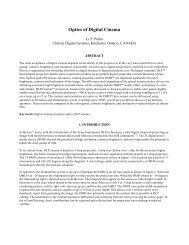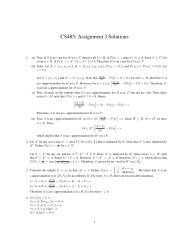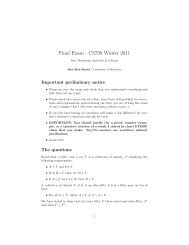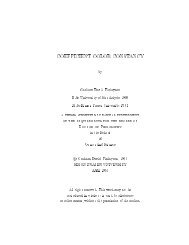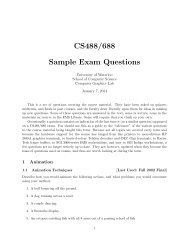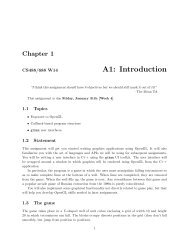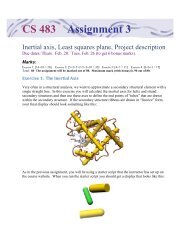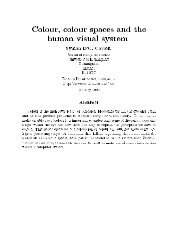Introduction: Data Structures and ADTs - Student.cs.uwaterloo.ca ...
Introduction: Data Structures and ADTs - Student.cs.uwaterloo.ca ...
Introduction: Data Structures and ADTs - Student.cs.uwaterloo.ca ...
Create successful ePaper yourself
Turn your PDF publications into a flip-book with our unique Google optimized e-Paper software.
Sorting<br />
CS 234: <strong>Data</strong> Types <strong>and</strong> <strong>Structures</strong><br />
Omer Beg<br />
David R. Cheriton School of Computer Science<br />
University of Waterloo<br />
Spring 2013<br />
Beg (CS, UW)<br />
CS234 - <strong>Data</strong> <strong>Structures</strong> 1
From Last Class …<br />
Binary Trees<br />
Beg (CS, UW)<br />
CS234 - <strong>Data</strong> <strong>Structures</strong> 2
Another implementation of<br />
ADT Priority Queue<br />
Implement an unbounded Priority Queue using<br />
a max-heap<br />
Store items with their priorities<br />
Use priorities to shape the heap<br />
Beg (CS, UW) CS234 - <strong>Data</strong> <strong>Structures</strong> 3
Heap-based Priority Queue<br />
Organization of data:<br />
_L – Python list to store items with priorities<br />
PriorityQueue()<br />
Set _L = []<br />
isEmpty()<br />
Does len(_L) == 0<br />
len()<br />
Return len(_L)<br />
Beg (CS, UW) CS234 - <strong>Data</strong> <strong>Structures</strong> 4
pq.enqueue(item, priority)<br />
Add item with priority to end of _L<br />
while item's priority > parent's priority:<br />
Swap item <strong>and</strong> parent<br />
Update indices for parent <strong>and</strong> child<br />
Beg (CS, UW) CS234 - <strong>Data</strong> <strong>Structures</strong> 5
Adding 90: What actually happens<br />
Beg (CS, UW) CS234 - <strong>Data</strong> <strong>Structures</strong> 6
And then …<br />
Beg (CS, UW) CS234 - <strong>Data</strong> <strong>Structures</strong> 7
Efficiency of enqueue<br />
Adding to end of heap:<br />
List/Array: amortized<br />
List/Array: worst <strong>ca</strong>se<br />
"Sifting" up –<br />
Maximum iterations<br />
Steps per iterations<br />
Total<br />
Overall: Worst <strong>ca</strong>se= _____ Amortized=_____<br />
Beg (CS, UW) CS234 - <strong>Data</strong> <strong>Structures</strong> 8
pq.dequeue() =><br />
item with maximum priority<br />
Move last entry into root<br />
While parent's priority < max children's priority:<br />
Swap parent <strong>and</strong> child with higher priority<br />
Update indices for parent <strong>and</strong> child<br />
Beg (CS, UW) CS234 - <strong>Data</strong> <strong>Structures</strong> 9
Efficiency of dequeue<br />
Removing/Swapping last <strong>and</strong> first of heap:<br />
List: amortized<br />
List: worst <strong>ca</strong>se<br />
Array:<br />
"Sifting" down –<br />
Maximum iterations<br />
Steps per iterations<br />
Total<br />
List Overall: Worst <strong>ca</strong>se= _____ Amortized=_____<br />
Array Overall: Worst <strong>ca</strong>se= _____ Amortized=_____<br />
Beg (CS, UW) CS234 - <strong>Data</strong> <strong>Structures</strong> 10
Another use of heaps<br />
Suppose we have a list L.<br />
Create an empty heap<br />
for each x in L:<br />
Add x to the heap<br />
for ind in range(n-1,-1,0):<br />
Remove max from heap, place in L[ind]<br />
We have a sorting algorithm!<br />
Beg (CS, UW) CS234 - <strong>Data</strong> <strong>Structures</strong> 11
Runtime of Heapsort<br />
Allo<strong>ca</strong>te array for heap to be same length as L<br />
Building the heap:<br />
Add is, at worst, O(log n)<br />
n elements added<br />
O(n log n)<br />
Refilling L:<br />
Remove is, at worst, O(log n)<br />
n elements removed<br />
O(n log n)<br />
Beg (CS, UW) CS234 - <strong>Data</strong> <strong>Structures</strong> 12
Improvements to Heapsort<br />
Algorithm requires extra array/list for heap<br />
Use the original array/list instead<br />
In-place algorithm<br />
Requires O(1) additional memory<br />
Have L share its space with the heap when<br />
Constructing the heap,<br />
Re-filling the array<br />
Heap: Uses first part of array/list<br />
Beg (CS, UW) CS234 - <strong>Data</strong> <strong>Structures</strong> 13
"in place" heapsort<br />
Insert first value into the heap:<br />
Insert 51 as new leaf, "sift up":<br />
Beg (CS, UW) CS234 - <strong>Data</strong> <strong>Structures</strong> 14
Beg (CS, UW) CS234 - <strong>Data</strong> <strong>Structures</strong> 15
Retrieving the sorted data<br />
Remove max from heap<br />
Place just past "end" of heap in array<br />
Repeat until heap "empty"<br />
Array is now in sorted order!<br />
Beg (CS, UW) CS234 - <strong>Data</strong> <strong>Structures</strong> 16
Beg (CS, UW) CS234 - <strong>Data</strong> <strong>Structures</strong> 17
Basi<strong>cs</strong> of Sorting<br />
L = [x 0 ,x 1 ,x 2 ,…,x n ]<br />
Collection of comparable data<br />
Comparable:<br />
Given two unequal values, <strong>ca</strong>n determine<br />
bigger <strong>and</strong> smaller<br />
For simplicity,<br />
Put into ascending order<br />
Beg (CS, UW) CS234 - <strong>Data</strong> <strong>Structures</strong> 18
Desirable Properties<br />
Comparisons of keys: O(n log n) worst <strong>ca</strong>se<br />
Swaps: O(n) worst <strong>ca</strong>se<br />
In place: Requires O(1) additional memory<br />
Stable: Equal keys are not reordered<br />
Special Case Performance ('adaptive'): Runtime<br />
approaches O(n) for nearly sorted data<br />
Beg (CS, UW) CS234 - <strong>Data</strong> <strong>Structures</strong> 19
A few basic sorts (to start)<br />
Bubble sort<br />
Selection sort<br />
Linear Insertion sort<br />
http://www.sorting-algorithms.com/<br />
http://www.<strong>cs</strong>.<strong>uwaterloo</strong>.<strong>ca</strong>/~bwbecker/sorting<br />
Demo/<br />
http://math.hws.edu/TMCM/java/xSortLab/<br />
Beg (CS, UW) CS234 - <strong>Data</strong> <strong>Structures</strong> 20





